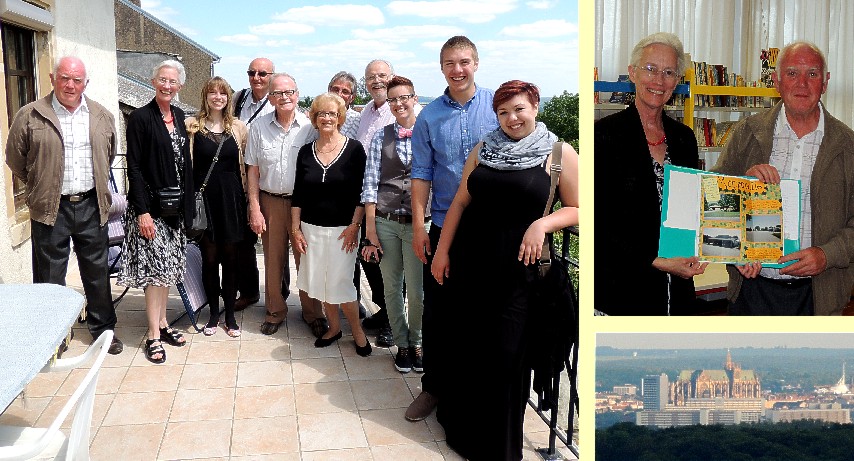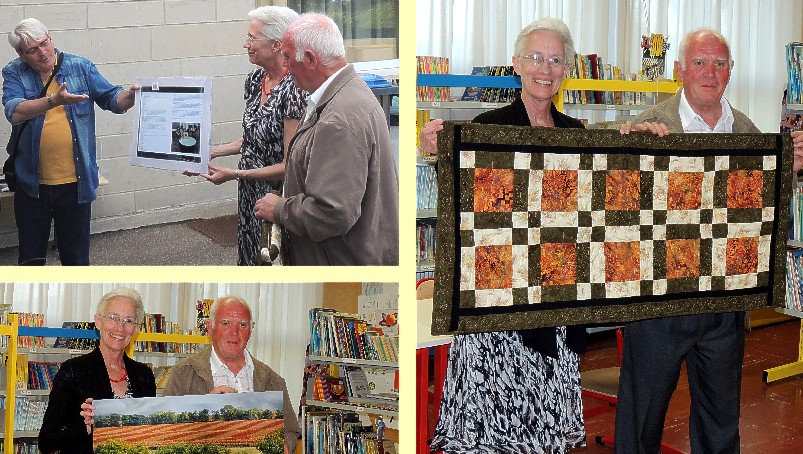Kansas Snapshots by Gloria Freeland - June 13, 2014
French connection
Every now and then, I hear about siblings reuniting after circumstance has separated them for years. This is such a story, but with a
twist - they were not siblings in the usual sense. They were two towns separated by an ocean, language and religion who were joined by war
years ago.
A column last November - “A small town, a big story” - told how the connection was made. Another this
past January - “What hath Todd wrought” - described how the two, one in Kansas and one in France, had taken a
first step to reconnect. Another step in that process occurred the Saturday before last when husband Art, daughters Mariya and Katie, and
Art’s cousin’s daughter Hannah and son Ryan and I were given an enthusiastic welcome in Fèves, a village of about 1,000 people six miles
northwest of Metz, France.
The connection began in 1948 when Morganville, Kan., a village of fewer than 300 citizens, chose to help Fèves recover from the effects
of World War II by staging a pageant to raise funds to buy items for the people of Fèves. The village had been liberated by Gen. George Patton’s Third
Army, but its location near key German defenses had left it 75 percent destroyed. Simple things such as rice, powdered milk, seeds to raise food
and school supplies for youngsters were dearly needed.
I had seen black and white photos and a few colored slides of Fèves from the late 1940s and 1950s and wondered what it would look 70 years
after World War II. What we found was a lively little town, thanks mainly to a flourishing industrial area on its eastern edge. The community
has a school for about 150 students, a church that has been serving its parishioners since 1521, a sports complex, a hall for weddings and other
events, and the village office. They are renovating the old presbytery, which will serve as the new village office when completed later this
summer.
But Fèves has not forgotten Morganville’s help, and it chose to express its gratitude on the occasion of our visit. We had been hoping some
people connected directly to Morganville would join us and several expressed the desire to do so, but spring is planting time on the Kansas
plains and those who make a living tilling the soil must respect nature’s cycles.
Gérard Torlotting was 6 in 1948 when the aid began arriving from Morganville. His Uncle Henri Torlotting, the schoolmaster, joined Mayor August
Berne and priest Louis Holveck to become the key players on the Fèves end of this “French Connection.” And today, Gérard is playing an equally
important role in reconnecting the two towns.
Gérard first led us to the Mairie - the village administrative building - where we were introduced to current Mayor René Girard and Mark
Davoli, a grandson of Berne. Jacques Ferry, a reporter for an area newspaper, and a few others were also present.
That was followed by a tour of part of the village, including what had been Father Holveck’s church, a beautiful Gothic-style building that
sits high on the hillside and overlooks the village below. The cathedral in Metz six miles away was clearly visible, just as it was in the pictures
we had seen taken from the Torlotting home in 1949.
We returned to the Mairie where many involved with the operation of the village had gathered for a lunch in honor of our visit. To say the
champagne and wine flowed freely would be an understatement.
Then it was off to visit the home where Henri and wife Mathilde had lived and which had also served as the village Mairie and school. The back
balcony was the spot where so many pictures had been taken when Morganville native Billie Utley and husband and amateur photographer Ed visited
in 1949.
From there, we went to the cemetery as we had asked to see Berne’s grave.
The tour continued at what had been an open-air community clothes-washing place after the war. But while no one is doing their laundry in a
public trough today, some things don’t change. We were shown the place and the equipment used where the area’s specialty, the Mirabelle plum,
is converted into what Art called Mirabelle liqueur. Earlier, Gérard had presented Art with a bottle of the prized liquid which is as clear
as water. Gérard’s brother-in-law Francis Pracht told Art he wasn’t correct. With a grin he said, “It isn’t liqueur; it’s pure alcohol!”
After a stop at Francis and wife Christiane’s place to share some drinks, we walked to the village’s new community and recreational facility.
They were in the process of preparing for a wedding that evening. Outside, a number of folks were involved in several games of Pétanque,
something I was completely unfamiliar with. The game is a bit like horseshoes, the principal goal being to get your team’s metal balls closer
than those of the other team to a small wooden ball.
It was then time for the big event at the Mairie. Approximately 100 people, some who were recipients of the 1948 aid, were awaiting our
arrival. We were greeted with a round of applause and then some words by Mayor Girard. After, he gave us a book on the history of the war.
Art and I then presented the town with a quilted table runner made by women in Morganville, a large picture of a milo field by a Morganville
photographer and a letter from a Morganville youngster who wants to have a Fèves pen pal. I also presented them with a framed letter written by
my three spring 2013 News and Feature Writing students who wrote about the 1948 Morganville pageant. In the letter, the students said they had
no idea a class assignment would end up with the two little villages reconnecting.
Francis, acting as Art’s interpreter, told the story of how at the start of the pageant, “The Star Spangled Banner” was to be sung. But a few
days before the pageant, Ivan Roenigk, a member of the U. S. Navy choir who had studied French, returned to his hometown of Morganville on leave. He
was convinced to sing “La Marseillaise,” the French national anthem, following the American anthem.
So, in honor of that event, Katie sang “La Marseillaise.” The people stood and applauded, and I saw more than a few wipe tears from their eyes.
Afterward, the people insisted she sing the “Star Spangled Banner” as well, which she did, accompanied by Mariya and me.
We then began an evening of chatter, hampered only slightly by our lack of French. A limited number of locals spoke some English. Ryan’s five
years studying French certainly paid dividends. Around 9 p.m., we returned to Francis’ home for another hour of conversation before we decided
we had better return to our place in Metz before Mariya and Art became too sleepy to drive our vehicles.
As we walked to our cars, I reflected on what a nice day it had been and all that had gone before that had led to this day. But those types
of thoughts tend to come later in life. So it was not surprising when one of the kids put it in a much more immediate vein.
“Boy, what nice people!”
I couldn’t have said it any better.


